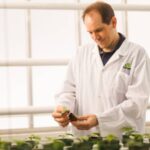UV Radiation and Applications in Horticulture
The effects of ultraviolet light (or UV radiation) on people are well known; it causes skin to tan and, with excessive exposure, can cause skin burn, skin cancer and eye damage. Effects of UV on plants are somewhat similar but not as well characterized and, thus, potential benefits of UV radiation are rarely utilized in horticulture. This article provides information about UV radiation and how it can potentially be used in the production of specialty crops in controlled environments.
There are three different kinds of UV radiation based on wavelength. UV-A radiation, which is barely visible to us, has the longest wavelengths (from 315 to 400 nm) and is the least energetic. Most of the UV-A radiation emitted from the sun passes through the ozone layer and, thus, it is the most abundant form of UV. UV-B (280 to 315 nm) and especially UV-C (100 to 280 nm) radiation are the most dangerous to people as well as plants. Fortunately, the ozone layer absorbs most UV-B and all UV-C radiation.
Sources of UV. Approximately 4 percent of the total radiation output from the sun is as UV, and most is as UV-A. In greenhouses, transmission of UV depends on the glazing material. Ordinary glass transmits 65 to 75 percent of UV-A but 3 percent or less of UV-B. Most plastics used to glaze greenhouses contain UV stabilizers to retard their degradation, but over time, these stabilizers also degrade and allow more transmission of UV. Therefore, UV transmission will depend on the plastic and its age.
Relatively small amounts of UV are delivered by conventional electric lamps used in horticulture. For example, the output of radiation as UV (on an energy basis) is about 1 percent for fluorescent, 3 percent for metal halide, and 6 percent for mercury vapor lamps, while high-pressure sodium lamps emit a negligible amount of UV (ten times less than metal halide lamps). There are LEDs that emit UV-A, UV-B and UV-C, and rapid advances in manufacturing are leading to greater longevity and efficacy while the prices are decreasing. However, they are still relatively expensive and their lifetime is usually substantially shorter than LEDs used for photosynthetic applications.
Effects on plants. UV is outside of the photosynthetically active waveband, but it is biologically active and regulates plant growth. Some common effects of UV on crops include inhibition of extension growth (shorter stems and smaller leaves), increase in leaf thickness and waxiness (thicker cuticles) and greater leaf coloration, especially for plants with purplish leaves such as red-leaf lettuce, purple millet and purple fountain grass. Research also has shown that plants grown with UV generally have less insect feeding on leaves and are less vulnerable to fungal pathogens compared to plants grown with little or no UV.
There are emerging, but not yet well defined, opportunities to use UV radiation (especially UV-A) in greenhouses and indoor vertical farms to produce crops with specific attributes and to suppress fungal pathogens. Potential examples include delivery of UV to increase leaf coloration and thickness, making plants potentially more resistant to environmental stresses and pests. Research is needed to determine how to deliver the UV to plants, including the radiation source and its intensity and duration needed to elicit the desired responses. An excessive dose will typically burn leaves and thus, determining the correct dose is extremely important.
Other applications and considerations. UV-C and sometimes UV-B are used to decontaminate water and surfaces, killing virtually all micro-organisms. These high-energy wavelengths could potentially be delivered to plants to kill pathogens on leaves as well. UV is also used by insects to help navigate to flowers. If the inside of a greenhouse is completely deficient of UV, both pollinators and pests may have a difficult time locating flowers.
Safety and precautions. Relatively small doses of UV can elicit desirable plant responses, but an excessive dose (intensity and duration) can damage and kill plants. More importantly, UV is dangerous to humans and other life forms, and can cause skin cancer and temporary or permanent eye damage. All UV devices should have warning labels and extreme precautions should be taken to ensure people are not exposed to UV treatments without protective equipment.









 Video Library
Video Library 


















